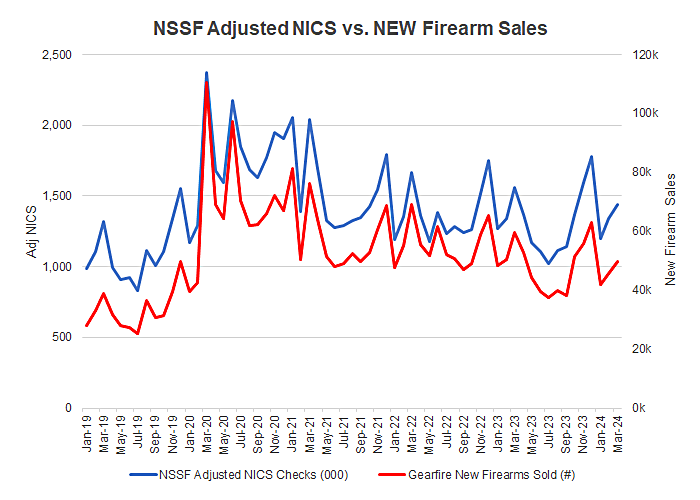
Business, Insight, Press Release
Gearfire’s RetailBI Uncovers Critical Flaw in Industry Forecasting Practices
Report Reveals Misalignment of Firearm Sales Data and NICS checks, Urging Manufacturers and Distributors to Rethink Data Sources
Ponte Vedra Beach, FL – Gearfire RetailBI, a leader in data analytics for the firearms industry, published the 2024 Q1 Sporting Sports Retail Executive Report in conjunction with their attendance at the NSSF Marketing & Leadership Summit. The firearms industry snapshot leverages retail sales statistics gathered from 2,500 contributing retailers in the Gearfire network to provide manufacturers and distributors reliable, real-world data intended for use in formulating meaningful insights for future production and inventory decisions.
Historically, manufacturers and distributors have relied on the monthly NSSF-Adjusted NICS or FBI NICS Reports to inform production and inventory needs by equating background checks directly to sales. The Gearfire RetailBI report reveals a significant disparity between actual firearm sales at the store level and the number of National Instant Criminal Background Check System (NICS) checks conducted. The findings suggest that while trends on the number of NICS checks may directionally align with in-store transactions, NICS checks are not one-to-one with actual gun sales, raising important questions about common practices used by manufacturers for forecasting and production decisions.
“Our analysis indicates a gap between the volume of background checks and the number of firearms sold,” said Kaleb Seymour, VP of Data Analytics. “This discrepancy could be attributed to various factors, including multiple purchases per check or denials, which the NICS reports do not address.”
Additionally, the report highlights the increase in on-hand inventory the retailers have accrued over the same period. The burden of the additional overhead undoubtably will impact future purchasing by retailers and compound the challenges the lack of store-level data may cause manufacturers and distributors when forecasting inventory needs.
Seymour continues, “Understanding the true landscape of the firearms retail environment is crucial for decision-makers at both the manufacturing and distribution level. Accurate retail sales data, coupled with inventory volume at the store level, helps craft informed policies and sound business decisions which positively impact the overall health and profitability of the entire firearms supply chain.”
Gearfire RetailBI remains committed to providing the firearms industry with actionable data insights and invites all industry stakeholders to access the 2024 Q1 Sporting Sports Retail Executive Report at no charge. For data customized to specific segments, brands, or regions, contact Kaleb Seymour at kalebs@gearfire.com.
For Latest News & Update
Want Receive the Best Gearfire Insights? Subscribe Now!
We can help you to create your dream platform for better business revenue.
